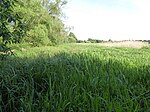Eriswell
Civil parishes in SuffolkForest HeathSuffolk geography stubsVillages in Suffolk

Eriswell is a village and civil parish of West Suffolk in the English county of Suffolk. About forty scattered archaeological finds have been made here, including Bronze Age battle axes, palstaves and rapiers. The greater part of these objects have been entrusted to the Moyse's Hall Museum in Bury St Edmunds while other items are in the Museum of Archaeology and Anthropology in Cambridge.
Excerpt from the Wikipedia article Eriswell (License: CC BY-SA 3.0, Authors, Images).Eriswell
West Suffolk
Geographical coordinates (GPS) Address Nearby Places Show on map
Geographical coordinates (GPS)
| Latitude | Longitude |
|---|---|
| N 52.367 ° | E 0.533 ° |
Address
Sparks Farm
IP27 9BB West Suffolk
England, United Kingdom
Open on Google Maps









